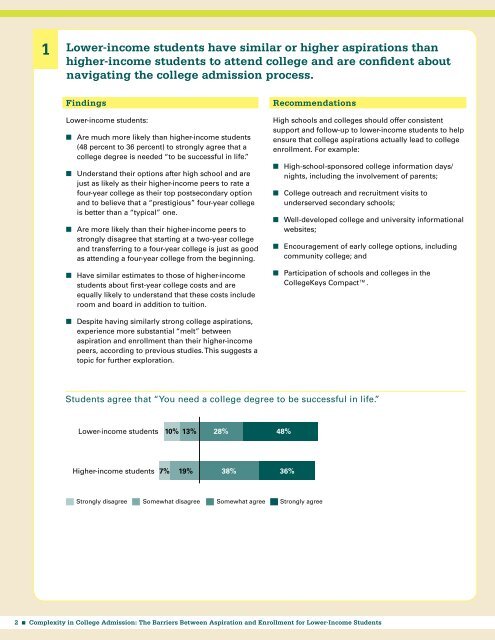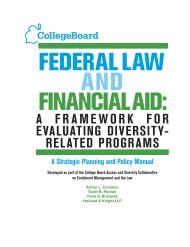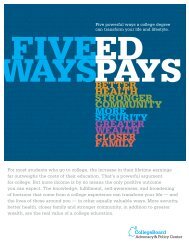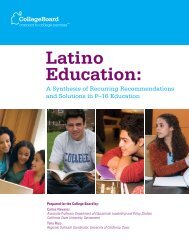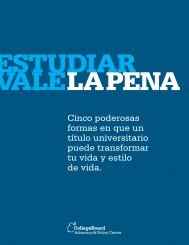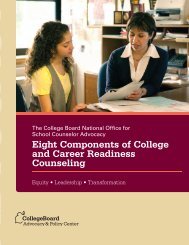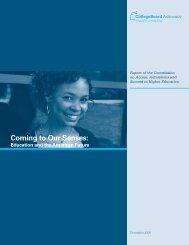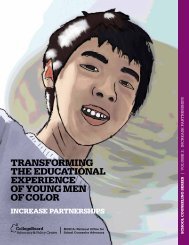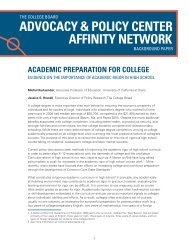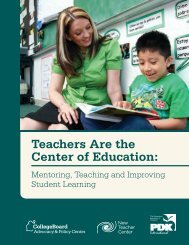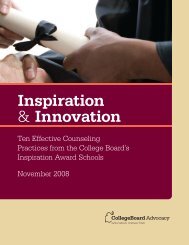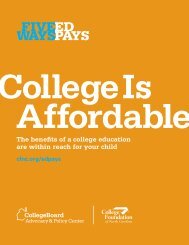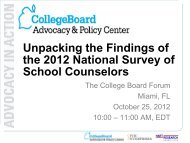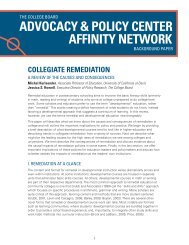Complexity in College Admission: The Barriers Between Aspiration ...
Complexity in College Admission: The Barriers Between Aspiration ...
Complexity in College Admission: The Barriers Between Aspiration ...
You also want an ePaper? Increase the reach of your titles
YUMPU automatically turns print PDFs into web optimized ePapers that Google loves.
1<br />
Lower-<strong>in</strong>come students have similar or higher aspirations than<br />
higher-<strong>in</strong>come students to attend college and are confident about<br />
navigat<strong>in</strong>g the college admission process.<br />
F<strong>in</strong>d<strong>in</strong>gs<br />
Lower-<strong>in</strong>come students:<br />
■■<br />
Are much more likely than higher-<strong>in</strong>come students<br />
(48 percent to 36 percent) to strongly agree that a<br />
college degree is needed “to be successful <strong>in</strong> life.”<br />
■■<br />
Understand their options after high school and are<br />
just as likely as their higher-<strong>in</strong>come peers to rate a<br />
four-year college as their top postsecondary option<br />
and to believe that a “prestigious” four-year college<br />
is better than a “typical” one.<br />
■■<br />
Are more likely than their higher-<strong>in</strong>come peers to<br />
strongly disagree that start<strong>in</strong>g at a two-year college<br />
and transferr<strong>in</strong>g to a four-year college is just as good<br />
as attend<strong>in</strong>g a four-year college from the beg<strong>in</strong>n<strong>in</strong>g.<br />
■■<br />
Have similar estimates to those of higher-<strong>in</strong>come<br />
students about first-year college costs and are<br />
equally likely to understand that these costs <strong>in</strong>clude<br />
room and board <strong>in</strong> addition to tuition.<br />
Recommendations<br />
High schools and colleges should offer consistent<br />
support and follow-up to lower-<strong>in</strong>come students to help<br />
ensure that college aspirations actually lead to college<br />
enrollment. For example:<br />
■■<br />
High-school-sponsored college <strong>in</strong>formation days/<br />
nights, <strong>in</strong>clud<strong>in</strong>g the <strong>in</strong>volvement of parents;<br />
■■<br />
<strong>College</strong> outreach and recruitment visits to<br />
underserved secondary schools;<br />
■■<br />
Well-developed college and university <strong>in</strong>formational<br />
websites;<br />
■■<br />
Encouragement of early college options, <strong>in</strong>clud<strong>in</strong>g<br />
community college; and<br />
■■<br />
Participation of schools and colleges <strong>in</strong> the<br />
<strong>College</strong>Keys Compact.<br />
■■<br />
Despite hav<strong>in</strong>g similarly strong college aspirations,<br />
experience more substantial “melt” between<br />
aspiration and enrollment than their higher-<strong>in</strong>come<br />
peers, accord<strong>in</strong>g to previous studies. This suggests a<br />
topic for further exploration.<br />
Students agree that “You need a college degree to be successful <strong>in</strong> life.”<br />
Lower-<strong>in</strong>come students<br />
10% 13% 28% 48%<br />
Higher-<strong>in</strong>come students 7% 19%<br />
38% 36%<br />
Strongly disagree<br />
Somewhat disagree Somewhat agree Strongly agree<br />
2 n <strong>Complexity</strong> <strong>in</strong> <strong>College</strong> <strong>Admission</strong>: <strong>The</strong> <strong>Barriers</strong> <strong>Between</strong> <strong>Aspiration</strong> and Enrollment for Lower-Income Students


